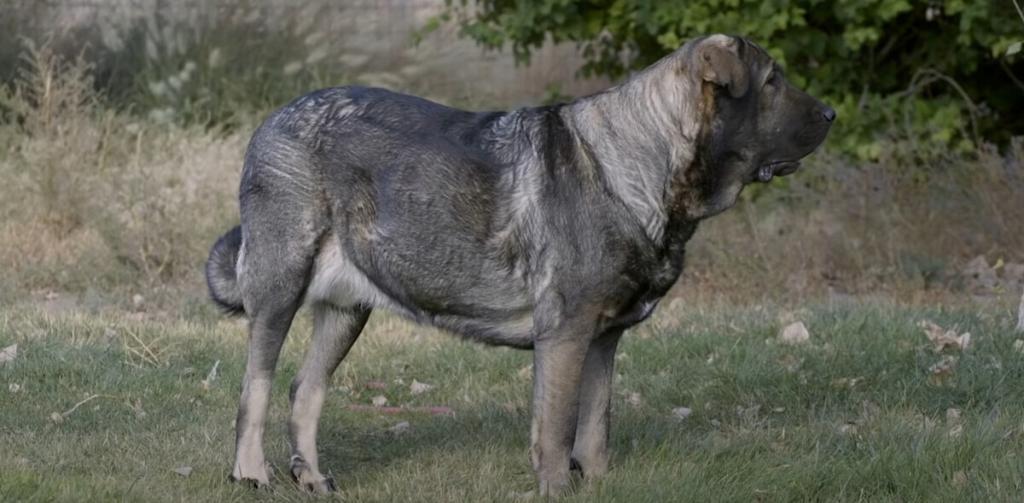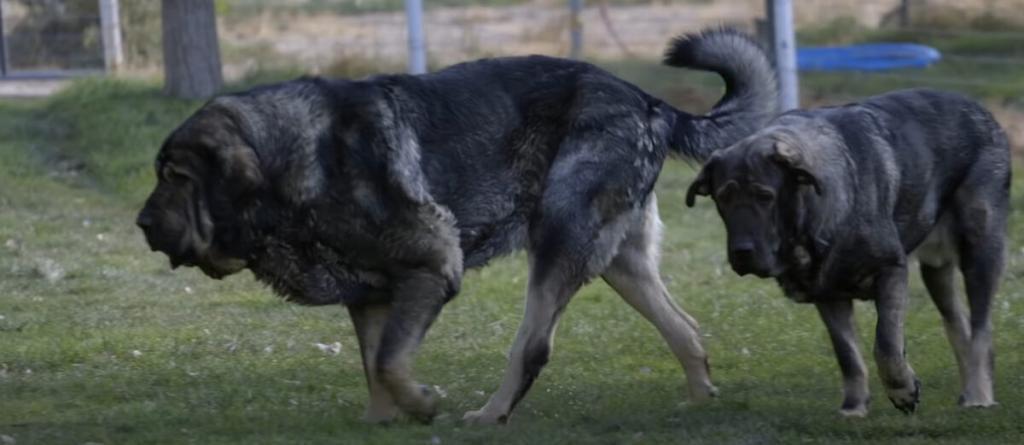Did you know the Spanish Mastiff is one of the heaviest breeds, with some males tipping the scales at over 200 pounds? As a guardian breed with ancient roots herding livestock in the Iberian Peninsula, history has molded them to be both formidable in size and gentle in nature.
You’re likely considering the Spanish Mastiff because of its reputation as a dedicated protector and a calm household companion, but it’s crucial to understand the responsibilities that accompany its care. Its thick coat and powerful build demand specific grooming and exercise routines, while its intelligence requires thoughtful, consistent training.
As you contemplate the role of this majestic breed in your life, consider the nuances of their temperament and the commitment needed to ensure they flourish as a part of your family. What does it take to provide the optimal environment for a Spanish Mastiff, and how do their characteristics align with your lifestyle?
Let’s embark on uncovering the answers.
- Noise Level
- Energy
- Sociability
- Trainability
- Care
- Health
Overall
Summary
The Spanish Mastiff is known for its moderate noise level, energy, and trainability. They are sociable dogs that require moderate care but generally enjoy good health.
Spanish Mastiff: Traits, Temperament, and Care Guide
The Spanish Mastiff exhibits a blend of dignity and strength, characterized by its calm demeanor, protective instincts, and unwavering loyalty to its family.
As a large livestock guardian dog, its protective nature is inherent, yet early socialization is imperative to temper any excessive suspicion toward strangers.
Their thick coat requires weekly grooming to manage shedding, occasional baths and nail trims.
Health problems like bloat, hip dysplasia, and entropion necessitate vigilant care and regular veterinary checkups.
It would be best if you didn’t overlook their exercise needs; despite their low energy, daily walks and a secure yard are essential.
Obedience training will harness the Spanish Mastiff breed’s intelligence and enhance your bond, ensuring they’re not just pets, but devoted companions rooted in the fabric of your home.
Exploring the Characteristics of the Spanish Mastiff
Building on the established understanding of the Spanish Mastiff’s overall nature, let’s examine the specific characteristics that define this noble breed. Known as Mastín Español or Mastín de España, Spanish Mastiffs are known for their imposing size and protective instinct—qualities that make them excellent guard dogs. This intelligent breed needs consistent, firm training from early puppyhood to ensure they grow into well-behaved adults. Proper socialization is critical to nurture their temperament and prevent unwanted aggression towards strangers or other animals.
| Characteristic | Description |
|---|---|
| Size | Males: 27-30 inches, 140-175 lbs; Females: 26-28 inches, 110-130 lbs |
| Temperament | Calm, gentle, fiercely loyal, requires experienced training |
| Activity Level | Low-energy; needs daily walks, access to secure yard |
| Health and Maintenance | Prone to bloat, dysplasia, requires regular vet checkups |
Spanish Mastiff: A Comprehensive Profile and Guide
As you seek to understand the Spanish Mastiff, consider its physical stature, temperament, and care needs.
You’ll find that their large size requires a dedicated approach to exercise and space, while their health considerations necessitate vigilant monitoring.
Proper socialization and training are imperative for integrating this breed into a family setting, ensuring they become well-adjusted companions.
Everything You Need to Know
When considering a Spanish Mastiff as your loyal companion, it’s crucial to understand their specific breed characteristics and care requirements to ensure a healthy and happy life together. Here’s a comprehensive profile based on the breed info center:
- Size and Presence: As a giant breed dog, the Spanish Mastiff boasts a robust build, with males significantly larger than females.
- Temperament: Known as Mastín Español in its homeland, this breed is a calm yet vigilant guard dog, demanding a strong pack leader for optimal training and socialization.
- Maintenance: Their double coat necessitates regular grooming, while their predisposition to hip dysplasia requires careful exercise management.
- Health and Longevity: As a working dog, maintaining a healthy weight and regular vet visits are essential for preventing common large breed issues.

Discovering the Temperament
The Spanish Mastiff displays a temperament characterized by a calm demeanor and protective instincts, ensuring they’re both gentle giants and vigilant guardians of their family. As a guarding breed, the Mastín Español possesses a strong personality deeply rooted in their history as a reliable livestock guard. They’re excellent guards, prone to certain protective behaviors, suggesting an innate sense of belonging to and defending their human pack.
This breed’s temperament is watchful, reflecting its traditional role in rural settings. Despite their size, Spanish Mastiffs typically exhibit a gentle approach towards their family members, especially children. Their loyalty and protective nature make them ideal companions for those seeking the comfort of a steadfast protector and a loving family member.
Spanish Mastiff: Is It a Good Fit for Families?
You may wonder if a Spanish Mastiff fits well within a family setting, especially with children. Their calm demeanor and protective nature can make them excellent family pets when properly trained and socialized.
However, their size and strength necessitate cautious supervision around kids and a clear understanding of the breed’s care requirements.
Assessing Spanish Mastiff’s Compatibility with Families and Kids
Assessing the Spanish Mastiff’s role in a family environment, this breed’s protective nature and strong familial bonds make it a commendable choice for households with children. Known in its native Spain as Mastín Español, the breed is:
- Good with Children: Their gentle disposition ensures they’re nurturing and patient, ideal qualities for a family pet.
- Large Size Consideration: Due to their size, supervision is crucial to avoid accidental injuries during play.
- Training & Socialization: A well-trained Spanish Mastiff, with a stable temperament, integrates well as a family member.
- Activity Level: Matching their activity level to family routines contributes to a harmonious living situation.
These factors and their protective nature make the Spanish Mastiff a reliable addition to families, provided they’re well-trained from an early age.
Spanish Mastiff Adjustability
Despite their size, Spanish Mastiffs require careful consideration regarding their adaptability to apartment living, as their energy levels and potential for excessive barking may pose challenges.
The Mastín Español, a large dog breed with a massive size comparable to the Great Pyrenees, can appear lazy, yet they require a lot of space to feel comfortable. While they may have a calm demeanor, their thick coat and need for daily walks mean they’re better suited to a home with a yard than a compact apartment.
If you’re seeking a canine companion, remember that the Spanish Mastiff thrives with room to roam. In an apartment setting, ensure you’re equipped to manage its size and needs, fostering a sense of belonging for both you and your gentle giant.
Spanish Mastiff Obedience Tips
Implementing effective training strategies to cultivate obedience in your Spanish Mastiff would be best.
Start with consistent, firm guidance to establish your role as the pack leader.
Early socialization is crucial to mitigate potential aggression and to ensure your dog’s interactions are well-managed.
Effective Training Strategies
To ensure your Spanish Mastiff becomes a well-mannered and obedient companion, initiate early socialization and consistent training from a young age. As a Mastín Español owner, particularly if you’re a first-time dog owner, you’ll need to use training methods that account for their sometimes intimidating bark and tendency for selective deafness. Remember, they may be large but agile and athletic, requiring much exercise to prevent musculoskeletal problems.
| Training Focus | Tips for Success |
|---|---|
| Socialization | Expose to various settings and animals early |
| Obedience | Use firm, consistent commands |
| Exercise Needs | Provide adequate, routine physical activity |
| Preventing Aggression | Redirect and correct any signs of aggression |
Through ongoing socialization and skilled training, it’s vital to prevent aggression, particularly towards other dogs.

Exercise and Grooming Needs
Caring for a Spanish Mastiff’s exercise and grooming needs is essential for their health and happiness.
This involves daily walks, weekly brushing, and regular vet check-ups.
As a Mastín Español owner, you’re familiar with their status as a Molosser dog breed, meaning these massive dogs don’t require a lot of exercise to stay happy and healthy.
However, daily ambles are imperative to prevent weight gain and mitigate health conditions.
Their coat, which drools and slobbers, demands attention, especially under high humidity.
Weekly grooming with a firm bristle brush controls shedding and maintains the coat’s luster.
Regular nail trims and ear cleanings are also part of their exercise and grooming needs, ensuring your gentle giant remains in top form.
Health Considerations
When considering a Spanish Mastiff’s health, it’s critical to recognize their susceptibility to certain genetic conditions, including bloat and hip dysplasia. To mitigate these risks, you must ensure they receive regular veterinary care and maintain a healthy lifestyle.
Common Health Issues and Lifespan
Many Spanish Mastiffs experience a lifespan of 10-12 years, yet they’re susceptible to several health issues, including bloat, hip/knee dysplasia, entropion eye, and panosteitis.
As a Mastín Español owner, you’re the guardian of a breed that’s a source of unconditional love yet requires vigilant care to mitigate common health issues.
Your Mastín may face heart problems if they grow too fast or too quickly, so maintaining a healthy weight is crucial. The Breed Info Center recommends regular vet visits for early detection of problems.
Smaller meals throughout the day prevent bloat, while slow-paced walks help manage joint health.
Is Spanish Mastiff the Right Dog for You?
Before welcoming a Spanish Mastiff into your home, consider whether their protective nature and space requirements align with your lifestyle. This breed of Spain, hailing from the Iberian Peninsula, has been revered for its ability to guard flocks of sheep against predators. The Mastiff is the largest Spanish dog breed, so they need ample space—ideally a large yard in a rural setting.
Despite their size, they may appear lazy, but this dog is likely conserving energy to protect its territory. Early socialization can mitigate aggression towards strangers, ensuring they’re gentle giants at Spanish dog shows and family gatherings.
Ensure you’re prepared to meet their weekly grooming needs and regular health check-ups to maintain their well-being.
Alternatives for Spanish Mastiff: Protective and Gentle Giant Breeds
For those who love the Spanish Mastiff’s protective nature and gentle demeanor, these giant breeds offer a similar combination of guardianship and kindness.
| Similar Dogs | Short Description |
|---|---|
| Saint Bernard | A large working dog, famous for its rescue instincts and gentle temperament. |
| Newfoundland | A gentle giant, excellent in water rescue and known for its sweet nature. |
| Bernese Mountain Dog | Renowned for its strength, calm demeanor, and loyalty. |
| Great Pyrenees | Known for its protective nature and calm, patient temperament. |
| Leonberger | A gentle giant known for its combination of strength and gentleness, great as a family companion. |
Conclusion
The Spanish Mastiff is the epitome of a gentle giant—fiercely protective yet profoundly tender with those it cherishes.
Committing to regular grooming and exercise will prevent health woes and ensure your colossal companion’s happiness.
Embrace this breed’s majestic presence and watch as it becomes the unwavering sentinel of your homestead.
With the right care, the Spanish Mastiff isn’t just a pet; it’s a monumental addition to any family.
